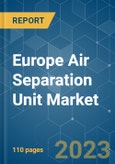The market studied was negatively impacted by COVID-19 in 2020. However, it has been recovering and now reached pre-pandemic levels.
Factors such as increasing demand for industrial gases, spurred by the growth in steel and process industries, are expected to drive the growth of the market studied during the forecast period.
However, high energy consumption and high capital costs are expected to hamper the growth of the European air separation unit market during the forecast period.
Growth in the infrastructure sector may increase the demand for steel and other materials, which is expected to create lucrative growth opportunities for the Europe air separation unit market during the forecast period.
Germany dominates the market and may witness the highest CAGR during the forecast period. This growth is attributed to the increasing investments and rising demand for industrial gases in different end-user industries.
Europe Air Separation Unit Market Trends
Cryogenic Distillation Segment is Expected to Dominate the Market
Industries with complex process configurations, such as the refinery, iron and steel, and manufacturing industries, are expected to hold the most significant demand for cryogenic distillation-based air separation units during the forecast period due to their continuous requirement for highly pure industrial gases to avoid any process disruption. Technology for separating air into its primary components (oxygen, nitrogen, and argon) by cryogenic distillation has been in practice for over 100 years.In 2021, LNG exports from Europe (including Russia) were 43.4 billion cubic meters. Russia accounts for the majority of LNG exports from Europe, followed by Spain and the Netherlands. Cryogenic distillation-based air separation units (ASUs) are largely applied across industries that consume large quantities of industrial gases (steel, refining, and petrochemicals) or require a multi-product supply, as they ensure a flexible and reliable supply for end users.
Nitrogen-only cryogenic distillation production plants are considered less complicated and require less power to operate than an oxygen-only plant, making the same product. Co-production of both products is deemed cost-effective in terms of capital and energy utilization, and it is expected to witness high demand during the forecast period. The LNG regasification process leads to natural gas formation, and the conversion process has huge potential for cold energy recovery. The integration of cryogenic ASU with LNG regasification units is getting popular, as it is considered a promising alternative for utilizing the cold energy of LNG.
Therefore, the increased focus by companies on business opportunities pertaining to the LNG sector is expected to boost the cryogenic distillation ASU market's growth during the forecast period.
Germany is Expected to Dominate the Market
Germany is a major market for industrial gases in Europe. The European Union has allocated a significant share of funds to infrastructure, ranging from 20% to 35%. The rise in investments for infrastructural development gives scope to the growth of industrial gas demand, which is expected to drive the demand in the air separation unit market in the coming years.Vehicles refer to motor vehicles that are used for transporting goods or paid passengers. In 2021, over 3.10 million unit vehicles were sold or registered in Germany. Sales fell by 11% from 2020 to 2021. The chemical and pharmaceutical industry in the country is the third-largest industry, behind only automotive, machinery, and equipment. The country is planning to increase its research and development spending from USD 14.44 billion in 2020 to USD 28.98 billion by 2050, which is expected to drive the chemical and pharmaceutical industry's in the country, in turn boosting the air separation units market in the country during the forecast period. In May 2022, Polish company PKN Orlen invested in an air separation unit for oxygen and nitrogen production at the Plock refinery in Germany. The project is estimated to cost USD 172 million and will be built by Linde Group and is expected to start operations by early 2025.
German car manufacturers are continuously expanding their foreign production capacity, attributed to the increasing international demand for high-value, premium small- and compact-sized cars and premium SUVs. The country's world-class R&D infrastructure, complete industry value chain integration, and highly qualified workforce have created an internationally peerless automotive environment. Hence, the increasing production of auto components is expected to increase the demand for ASUs during the forecast period.
Therefore, the rise in investments for infrastructural development boosts the growth of industrial gases, which is expected to drive the air separation unit market's growth during the forecast period.
Europe Air Separation Unit Market Competitor Analysis
The European air separation unit market is moderately consolidated in nature. Some of the major players in the market (in no particular order) are Air Liquide SA, Linde PLC, SIAD Macchine Impianti SpA, Air Products & Chemicals, Inc., and Messer Group GmbH.Additional benefits of purchasing the report:
- The market estimate (ME) sheet in Excel format
- 3 months of analyst support
This product will be delivered within 2 business days.
Table of Contents
Companies Mentioned (Partial List)
A selection of companies mentioned in this report includes, but is not limited to:
- Air Liquide SA
- Linde PLC
- Enerflex Ltd
- Air Products & Chemicals Inc.
- Messer Group GmbH
- Universal Industrial Plants Mfg. Co. Private Limited
- Taiyo Nippon Sanso Corporation
- SIAD Macchine Impianti SpA
- SOL SpA
- Matheson Tri-Gas Europe GmbH
Methodology

LOADING...










